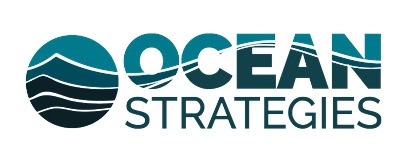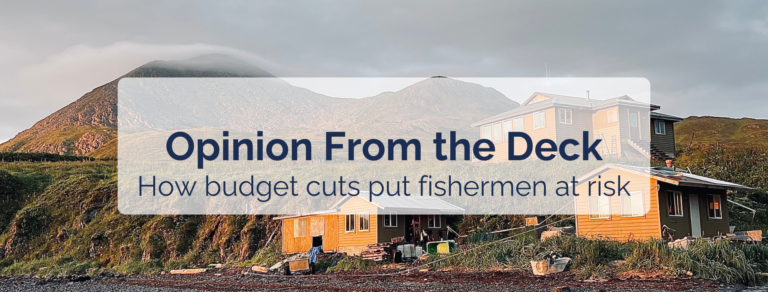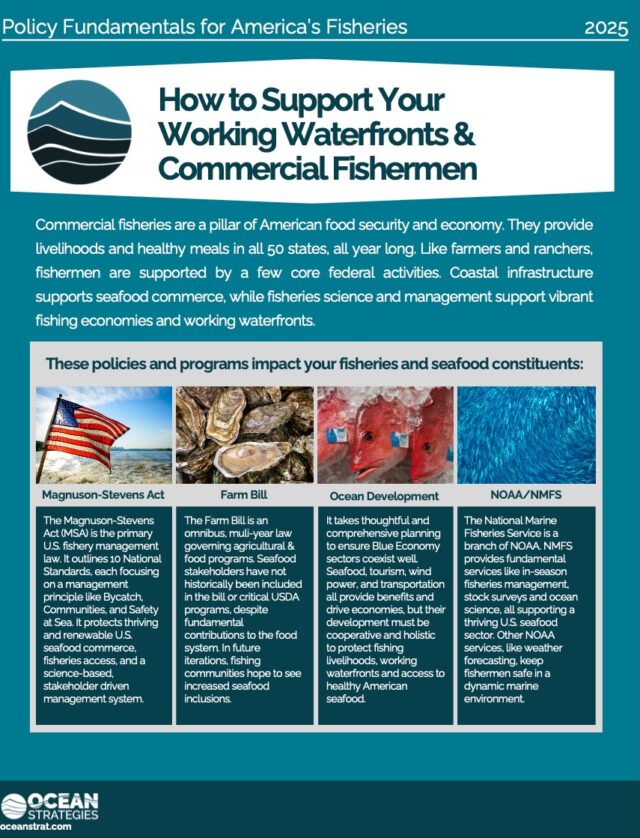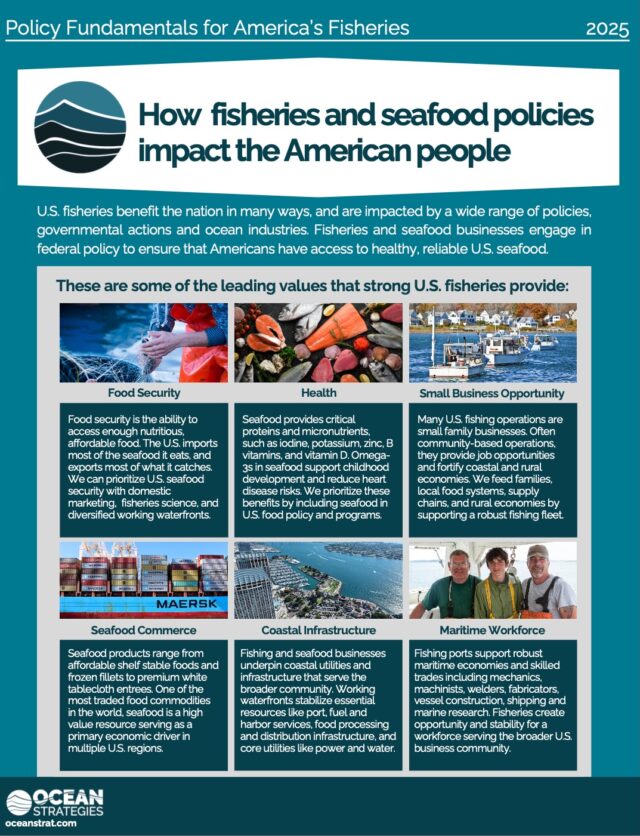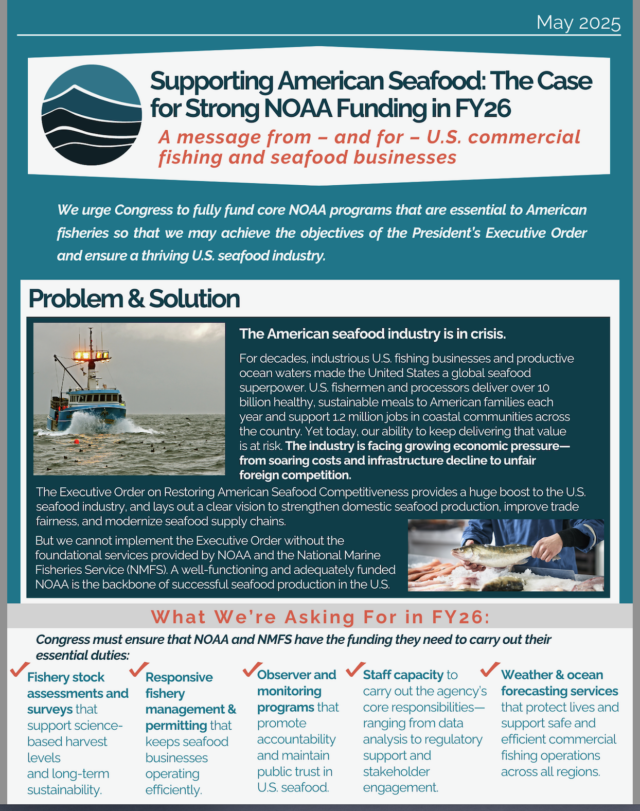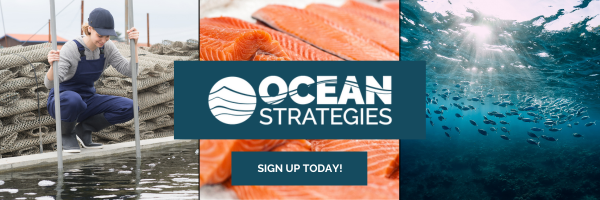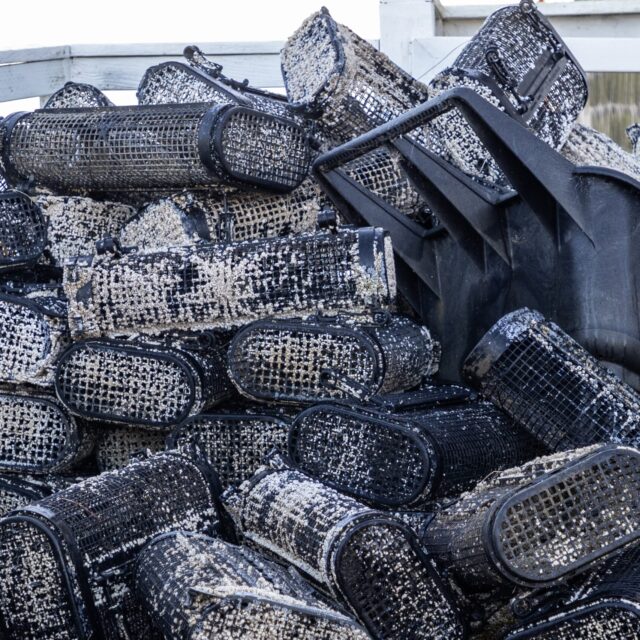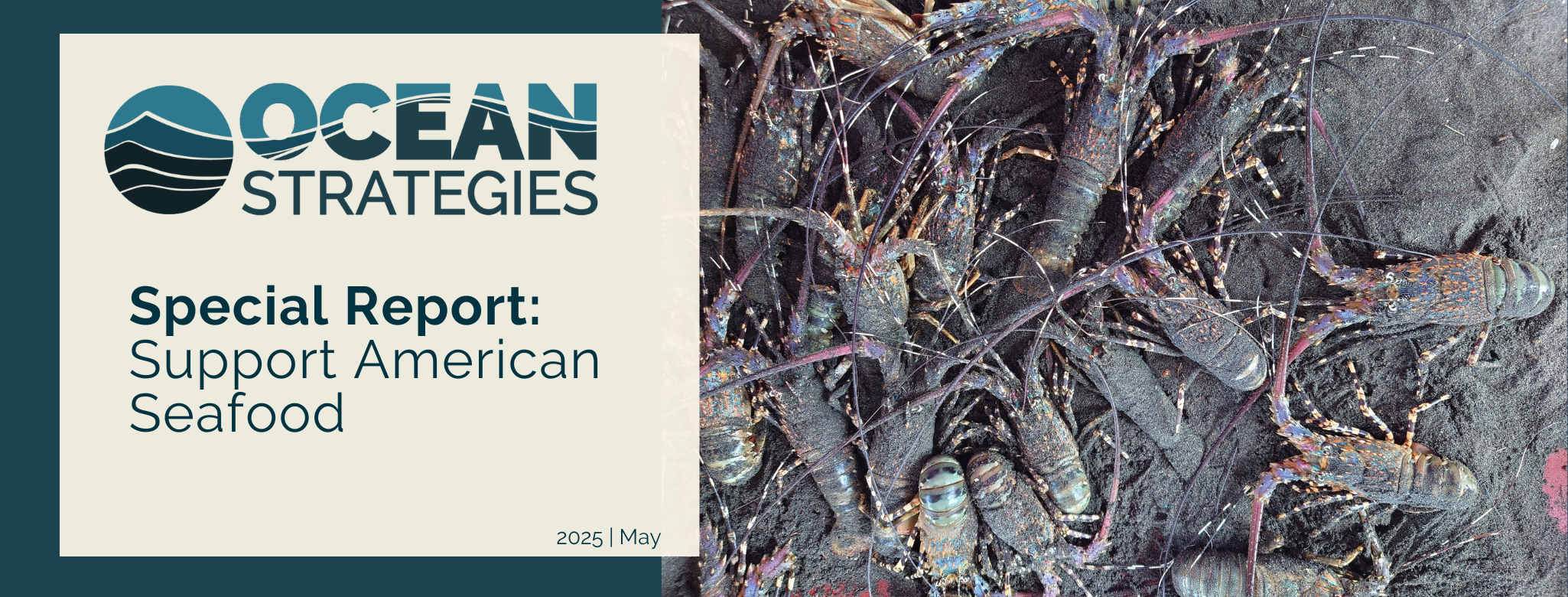
Ocean Strategies is a public affairs firm specializing in seafood, fisheries and marine resources.
This special report provides an analysis of essential NOAA/NMFS services; how they impact fisheries and seafood business, and more. Sign up here.
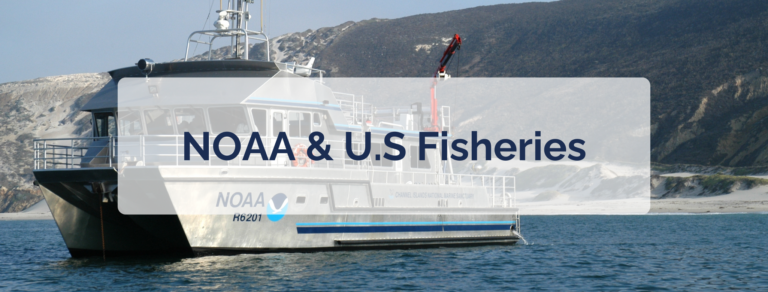
For commercial fisheries, tariffs offer a mixed bag
As the global markets shuffle up and down with swings of tariff negotiations, some commercial fishing groups stand to win marketshare if overseas products are expected to enter the domestic market with duties that bring them closer to par with American products.
In early April, the administration announced sweeping tariffs on all imports, then pulled back to a 10 percent baseline — except 125 percent for Chinese goods — for a 90-day period, during which negotiations may take place with other trade partners.
One clear winner in the tariff do-si-do is wild domestic shrimp, especially from the Gulf and Southeast coasts. Cheaper farmed imports have long been subbing for local and wild products.Wild American shrimp are harvested with strict regulations, more expensive labor and, therefore, a higher price tag.
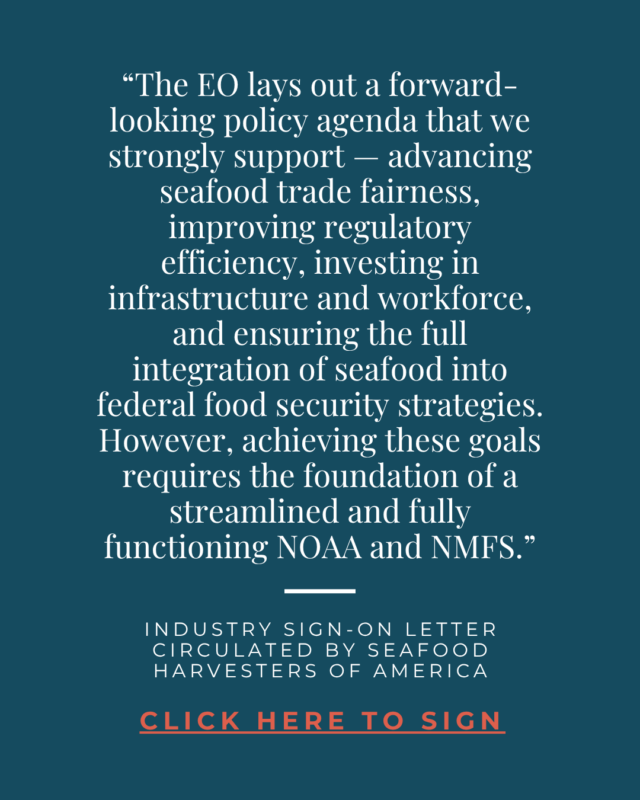 Used intentionally, tariffs can be a critical lever to pull in leveling the playing field when it comes to highly regulated industries that compete with cheaper, less regulated imports, or even in some cases in competition with well-regulated industries that are heavily subsidized by their own governments.
Used intentionally, tariffs can be a critical lever to pull in leveling the playing field when it comes to highly regulated industries that compete with cheaper, less regulated imports, or even in some cases in competition with well-regulated industries that are heavily subsidized by their own governments.
For example, the primary objective of the Saltonstall-Kennedy Act is to use import duties on foreign marine products to help promote and develop U.S. fisheries for the benefit of “fishing communities,” defined by the S-K program as “harvesters, marketers, growers, processors, recreational fishermen, charter fishermen, subsistence fishermen, and persons providing them with goods and services.”
We have all heard the stat that more than 80 percent of our domestic seafood consumption consists of imports (and that the stat does not delineate our own products that we export for overseas processing and reimportation to the domestic market). If we had more funds for the S-K program, U.S. fishermen might have a better chance of selling their catch into competitive domestic markets, and we’d also be funding innovation for new products, processing technology and investment in infrastructure that helps fishing communities more broadly.
The act stipulates that 30 percent of the import duties of marine products should be used for promotion and development of U.S. fishery products, with 60 percent of those funds going to the S-K program, which is overseen by an industry-led committee. In recent decades, the overwhelming majority of the funds have been siphoned off to support NOAA’s Operations, Research, Facilities before they can be designated for the S-K program. While those are important activities for fishery management, they have nothing to do with the S-K program or with any promotion or marketing purposes.
In FY24, for example, $376.4 million was transferred to the “Promote and Develop” (P&D) account. Sixty percent of that is $225 million, which should have been designated for the S-K program. Instead, the program got less than 2 percent of those funds, and the other 98 percent supported NOAA operations.
Without key programs in place to direct tariff funds toward critical marine infrastructure, innovation, domestic processing, industry stakeholders are less likely to benefit from the import duties that will affect the overwhelming majority of the supply chain.
NOAA’S role in achieving seafood competitiveness goals
NOAA and NMFS are the backbone of stable U.S. fisheries — they provide the science, staffing, and support that keep fishing businesses legal, safe, and running strong. They’re also key to helping the country reach its goals under the new Seafood Executive Order and National Seafood Strategy. But right now, NOAA and NMFS are stretched thin and projected to get thinner.
So what does that really mean for harvesters, processors, the supply chain, and ultimately to seafood consumers?
It means the services we count on — the ones that keep boats on the water and seafood moving to market — are at risk. These aren’t just nice-to-have programs. They’re essential for our economy and our food supply. Cuts to these services mean we could lose both the chance to optimize our industry as well as the tools that help us avoid disaster.
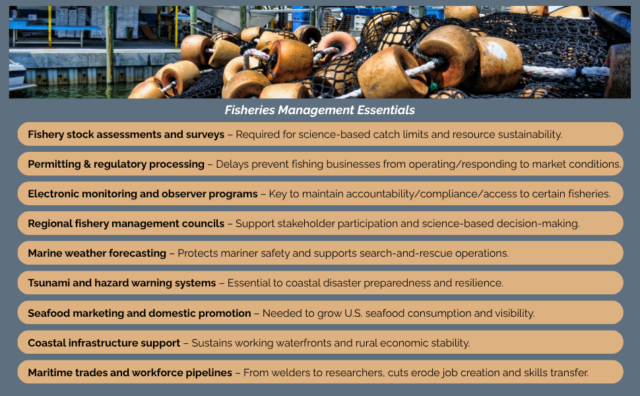
To put it plainly: Fishermen can’t fish, processors can’t operate, and Americans can’t eat American seafood if the core agency responsible for managing the ocean economy is underfunded.
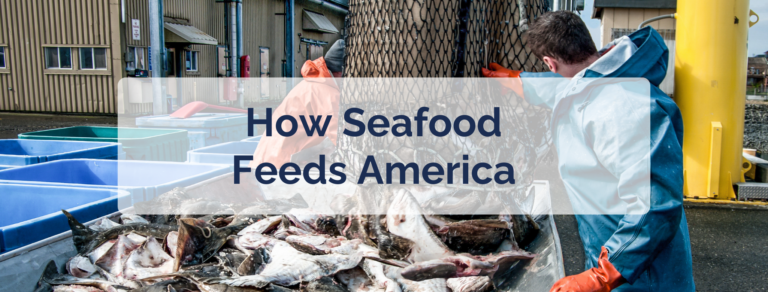
Investing in American growth and resilience
America’s fisheries are more than regional industries — they are a strategic national asset. Commercial fishing and seafood commerce support food security, economic competitiveness, coastal infrastructure, and public health in every U.S. state. The success of this sector depends on core federal services provided by NOAA and NMFS, from science and permitting to safety and forecasting.
Proposed FY26 budget cuts to these agencies threaten to undermine critical services, jeopardizing not only fishing businesses but also broader American priorities like rural job creation, food access, economic resilience, and national supply chain security. Below are the national benefits now at risk:
- Food Security
U.S. fisheries deliver more than 10 billion seafood meals annually — a vital source of protein and micronutrients. NOAA programs support the science, safety, and management that keep domestic seafood moving from ocean to plate. Undermining these systems weakens America’s ability to feed itself and increases reliance on less-regulated imports. - Working Waterfront Infrastructure
Fishing and seafood businesses stabilize coastal infrastructure used by entire communities — including ports, harbors, fuel, electricity, water systems, and cold storage. These assets are essential not only for fisheries, but also for emergency response, national defense readiness, and maritime commerce. - Health and Nutrition
Seafood is among the most nutrient-dense foods available, rich in omega-3s and essential vitamins. Including more seafood in American diets helps fight heart disease and supports childhood development. NOAA’s work underpins this health benefit through reliable science, sustainable harvest, and domestic availability. - Skilled Workforce Development
Ports and processors support trades like mechanics, welders, engineers, and marine scientists. Federal investments in data collection, permitting, and science partnerships help train and retain a skilled maritime workforce — a key pillar of the broader blue economy. - Seafood Commerce and Trade
American seafood is a top-tier global product. NOAA services ensure access to fishing grounds, timely permitting,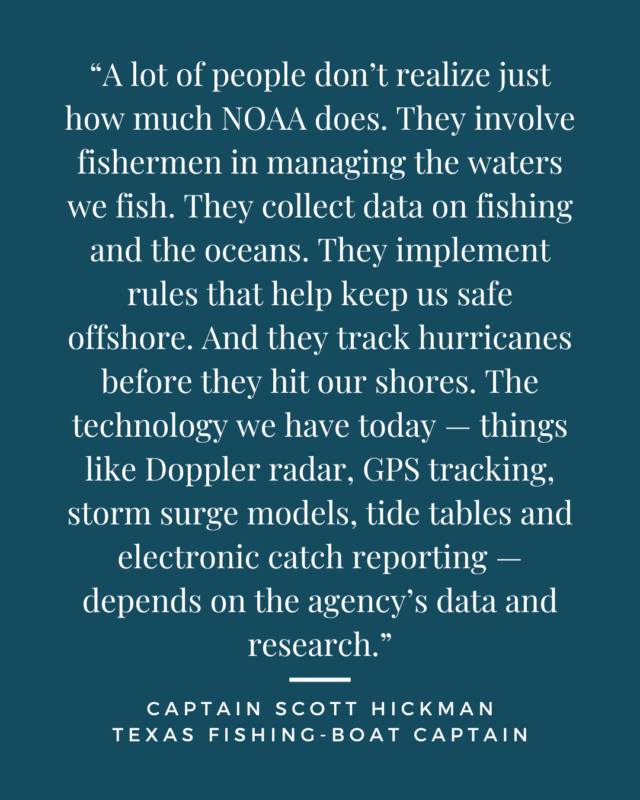 fair trade practices, and modernized data systems. Cuts to these programs weaken U.S. competitiveness and leave our supply chains more vulnerable to foreign market manipulation.
fair trade practices, and modernized data systems. Cuts to these programs weaken U.S. competitiveness and leave our supply chains more vulnerable to foreign market manipulation. - Small Business OpportunityMost U.S. fishing operations are small, family-run businesses rooted in rural and coastal communities. These businesses create local jobs, drive regional economies, and anchor supply chains. NOAA programs — from in-season management to electronic monitoring and council support — provide the backbone of regulatory certainty and operational viability.
Seafood producers, processors, and community leaders have a real opportunity to come together and help federal decision-makers understand just how crucial NOAA and NMFS are to our industry. Funding these programs at levels that match the importance of American seafood is key — both to feed families and support the hardworking communities that rely on the sea, while also helping to unlock the full economic and nutritional potential of seafood from coast to coast.
By Hannah Heimbuch
“During fishing season, my life revolves around weather. There’s fish to find, tides to work with, regulations to follow—but nothing rules the day like wind and wave.
I fish from a 26-foot open skiff along the rocky coast of Kodiak Island, where the North Pacific can turn on a dime. Like hundreds of thousands of mariners across the country—commercial fishermen, ferry captains, harbor workers, and recreational guides—I rely on federal agencies like NOAA to do my job safely.”
Don’t miss Hannah’s entire op-ed over on the Ocean Pulse blog.

Seafood stakeholders need to tell their story
Here are some tools and opportunities to do that.
Opportunities
1. Collaborate.
Seafood Harvesters of America is asking fishing and seafood businesses and trade organizations to sign onto this letter, focused on the industry’s immediate needs from the FY26 appropriations process. It supports foundational funding and staffing for NOAA and NMFS, recognizing that core agency services underpin America’s fisheries and seafood success.
The Fishing Communities Coalition drafted a letter to Commerce Secretary Howard Lutnick this spring, advocating for U.S. fishing communities. Signed by 170 fishing and seafood businesses, organizations, and individuals hailing from 98 coastal communities in 22 states. The letter details the short- and long-term priorities of the U.S. commercial fishing industry and offers strategies for the Trump administration to address market challenges, reduce instability and unpredictability, and make targeted, strategic investments in the success of U.S. fisheries.
2. Contact your delegation
Reach out to your senators and representatives to share how federal programs and services affect your fishery. Direct constituent input carries weight — especially when it comes from businesses and communities directly impacted.
- Share Real-World Impacts of Service Reductions
Whether it’s a delayed permit, canceled survey, disrupted catch schedule, or weather warning gap — make it personal. Share specific examples with congressional staff that show how budget cuts are already affecting your operations, workforce, or community.
- Support Transparency and Reporting from Federal Agencies
Clear reporting from NOAA and NMFS on how cuts are impacting core functions help stakeholders, oversight officials, and the public understand where gaps are forming — and how to fix them.
-
Highlight Seafood’s Role in National Food Security and Health
American seafood is an essential food source that feeds millions, supports heart health, and reduces diet-related disease. Federal food security policy should prioritize safe, sustainable, domestic seafood. -
Emphasize Economic and Small Business Impacts
Most fishing and seafood operations are small businesses that create jobs, power regional economies, and contribute to trade. Stress that federal investment in NOAA is not a subsidy — it’s the foundation that allows rural enterprise to function and grow.
3. Reach out to your industry trade organization.
If you’re feeling the impact of budget cuts or policy changes, you don’t have to go it alone. Getting in touch with your local, regional, or national trade organizations can help you speak up more effectively and stay in the loop. Here’s how they can back you up:
-
Team Up for a Stronger Voice
When fishermen and seafood businesses speak together, the message carries more weight. Trade groups help coordinate that message across different regions and fisheries, so policymakers hear a unified, powerful call for action. -
Get Tools and Info That Make Advocacy Easier
Need talking points, a sample letter, or just help understanding what’s going on in D.C.? These organizations usually have resources ready to go — and staff who can walk you through the latest developments and how they affect your business. -
Stay Connected to the Big Picture
Trade organizations keep close ties with Congress, NOAA, and other agencies. By working with them, you stay part of the bigger conversation — and help shape the future of U.S. fisheries and seafood policy, not just react to it.
Here is a list of links to our most recent policy reports. You are always able to find them on our Ocean Pulse Blog. If you’d like to receive them directly, just sign up here.
